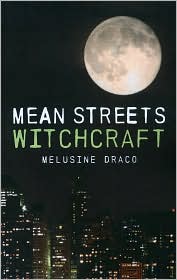(Ed. note: This book was actually published under the title Traditional Witchcraft for Urban Living.)
Author Melusine Draco makes it clear that the energies of nature are everywhere from concrete blocks to wild forests. This excellent theme calling for a rethink of common magical attitudes unfortunately runs far afield from its theme of urban witchcraft shortly thereafter. After an excellent exploration where the reader classifies their urban environment under the classic western element system, Draco then rushes down a dark alleyway and hops on an ill-chosen soapbox.
Draco has some strong opinions about Wiccans and the other magic practitioners who do not identify as “Old Craft.” What begins as making a valid distinction slips into diatribe: she goes so far in her criticisms as to misrepresent some of her opinions as fact. While the assertion that the practice of witchcraft is not in itself a religion has backing from centuries of anthropological study, Draco’s assertions about neopaganism border on the inflammatory. “Many pagans are highly suspicious of witches and some will deny that they practice any form of magic at all. Paganism caters for teenagers within the community and actively encourages them to attend the fairs, buy the books and any appropriate accoutrements. Pagans claim to worship Nature in the persona of ‘the Goddess.’” That this ignores a vast variety of religions tucked within Paganism, some of which are far more specific in the focus of their practice than “Goddess” and most of whom are well over the age of 18 indicates that Draco has had at best limited exposure to the real people whom she targets in this rant.
Draco could easily establish that her practice of witchcraft is non-religious without the insistence that neopaganism is essentially a marketing scam on children. Her broad generalizations and ignorance about other traditions undermines the authority she attempts to establish within the text.
Along with comments that suggest severe ethnocentrism, Draco also has holes in her research of herbal correspondences. She does not state that she referred exclusively to Culpepper’s Herbal for her symbolic alignments (although those are the only herbals listed in the bibliography) and she also ignores that magical herbalists of the twentieth century have ventured so far as to assign plants such as aloe a planetary correspondence. Perhaps, because the practitioners who went so far as to identify the plant’s alignment exist outside her tradition, she simply ignored them. Given that research in herbalism has advanced enough to merit an annual issue of the Physician’s Desk Reference on the subject, Draco might consider it beneficial to explore updated material on herbalism both from scientific and spiritual communities.
Along with the audience-alienating attitudes, Draco has some other off-topic fare filling out the book: chapters on tarot, “seeing” and the much overdone Sabbat-by-Sabbat material flesh out the book.
Yet when Draco writes about magic in an urban context, she does an outstanding job. She reframes the urban into the magical, and offers excellent passages on interpreting animal omens from critters common to cities, using protective magic to handle problems associated with population density, and incorporating plants into the home as part of a magical practice.
This book has excellent information where the information is good, but it also has a hostile attitude in its underpinnings that undermines the strength of its best parts. The good ideas deserve attention but the misinformation can’t be ignored. This book is best for those practiced in distinguishing between fact and opinion, and while more books are needed on adapting witchcraft practices to urban life, this sadly works against itself in breaking new ground.
Recommended with reservations
~ review by Diana Rajchel
Author: Melusine Draco
O Books, 2010
pp. 152, $19.95

